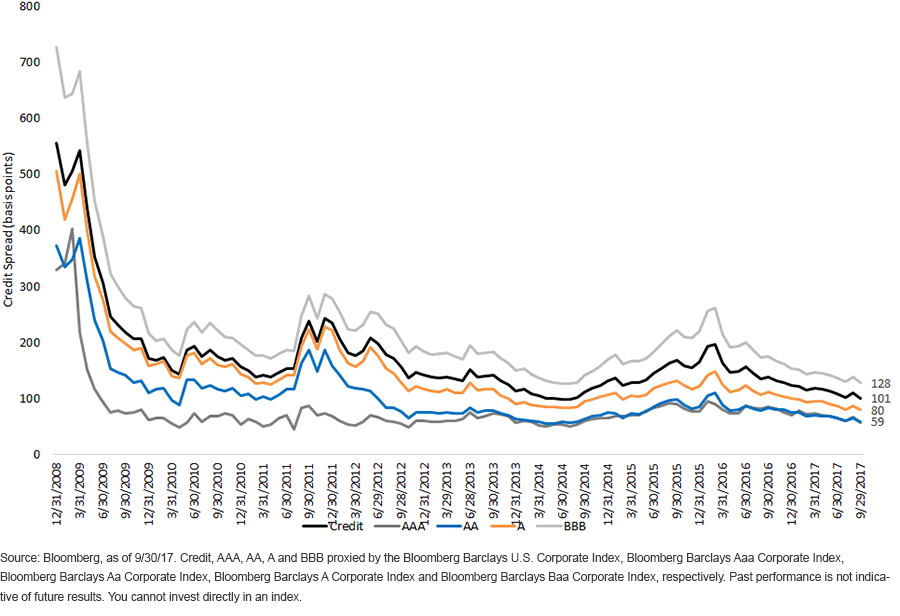Bullish U.S. Corporate Credit: The Other Side Of Tax Reform
Although many investors remain focused on the potential impact of U.S. tax reform on corporate earnings, we believe any change in tax policy can have an equally important effect on the price and supply of corporate credit. While the remainder of this piece will highlight this logic, our unambiguous takeaway is that we believe credit can continue to outperform low-risk assets over the next 12 to 18 months.
Financial Impact
As we explained previously, companies with high marginal tax rates may see the most significant effect on their earnings. However, in order to blunt the net revenue impact to the government, the Trump administration has also proposed that it may want to partially limit the tax deductibility of interest expenses. In our view, it is likely that this provision will be used as a bargaining chip with deficit hawks, as previous estimates found that interest deductibility costs the federal government $27 billion per year.1 Assuming a zero multiplier, this could generate nearly $270 billion in net revenue for the government over the ever important 10-year CBO scoring period. To potentially dampen this de facto tax increase on companies, they would also likely make capex fully deductible in the first year.2
Under the current system of interest expense and capex deductibility, leverage has a negative tax rate.
Turning back to Finance 100, firms should theoretically seek to maximize the efficiency of their capital structure by attempting to minimize their cost of capital. Given that corporations are currently able to deduct their interest expense, firms tend to deploy leverage in order to optimize their financing mix. Put another way, a company’s demand for debt should be proportional to the relative cost of equity and the firm’s benefit from the corporate debt tax shield. In the short run, tax cuts could increase earnings, increase free cash flow and stabilize P/E multiples. In the long run, tax cuts could diminish the benefit of the corporate debt tax shield, decrease leverage and shift corporations away from debt, thus increasing the demand/cost of equity. However, given that legacy debt would likely be grandfathered in,3 these changes would occur only as previously issued debt rolled off/matured. In our view, this implies that corporate debt issuance could decline and aggregate credit quality could improve.
Is Credit Cheap or Expensive?
In the chart below, we show the current incremental cost that investment-grade corporations must pay to borrow. Earnings growth has been robust, global economic growth has been accelerating and many financial markets are near all-time highs. Similarly, the cost of credit is approaching the lows of the cycle. For many investors, this implies that it may make sense to reduce credit risk in bond portfolios. While that may have been true for tactical players, absent a catalyst for a retracement, we believe strategic investors should continue to benefit from higher yields offered by riskier credits. Below, we highlight our rationale for why credit spreads may be ready to tighten to fresh all-time lows.
Credit Spreads by Rating Bucket, 12/31/08 –9/30/17

Market Technicals
A decrease in the long-run financing needs of corporations implies that with constant investor demand, credit spreads should tighten. This logic is largely predicated on the idea that with less debt, companies may rely on a larger percentage of equity financing. This shift toward equity could mean that the actual risk of bonds not being repaid should decline. As a result, credit spreads at the very highest rungs of the spectrum could shift to primarily become a function of liquidity risk in the bond market as opposed to credit risk. In our view, while a spread should exist between rating buckets, it is likely that you would see a meaningful parallel shift lower in credit spreads over time. Similarly, with less supply coming on to the market in the long run, it is also possible that bond market liquidity could actually improve despite current concerns to the contrary.
In a recent note by Goldman Sachs,4 it proposes that companies with strong profitability, high capex needs and comparatively low interest expenses are likely to be the key beneficiaries of the likely shift in policy. Put another way, the types of businesses screened by our fundamental approach to investment-grade credit. The WisdomTree Fundamental U.S. Corporate Bond Fund (WFIG) screens publicly traded companies with attractive free cash flow/debt service, leverage and return on invested capital. As a result, free cash flow could be likely to increase, leverage is likely to decline further and more profitable companies could see a greater benefit.
In sum, taxes will likely have a greater impact for equity investors, but their benefits should not be discounted for fixed income. While far from a done deal, should the deductibility of interest income be reduced or eliminated, there may be a long-run structural bull case for a reduction in credit spreads going forward.
1Source: Congressional Budget Office, 2017.
2Under the current system, 50% is deductible in the first year with the remainder being deductible at an accelerated depreciation rate.
3This eliminates the impact on nonoperating profitability
4Goldman Sachs, The Credit Trader, 9/28/17.
Disclaimer: Investors should carefully consider the investment objectives, risks, charges and expenses of the Funds before investing. U.S. investors only: To obtain a prospectus containing this ...
more


